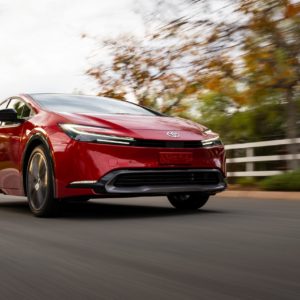Automakers took their innovations to the next level when hybrid electric vehicles began to share the road with internal combustion engines.
Drivers can have the best of both worlds with a hybrid vehicle, as well as a set of unique features that make driving fun and exciting. One of these features is the EV mode.
What Does EV Mode Mean?
EV mode (or motoring mode) is a feature typically found in hybrid EVs. Once activated, it restricts fuel usage and lets the electric motor propel the vehicle on its own.
A hybrid vehicle using this mode essentially works like an EV because it’s not using fuel and no emissions are released.

Most hybrid vehicles一particularly medium and full hybrids, usually have EV mode.
Mild hybrids, on the other hand, aren’t capable of propelling the vehicle with an electric motor alone. These hybrids still rely on the power of an internal combustion engine.
How Does EV Mode Work?
EV mode operation can vary, depending on vehicle specifications.
In the case of most Toyota hybrids, for example, an EV mode button can be found on the center console. When the button is pressed, an “EV Mode” indicator will appear on the multi-information display, and power will automatically come from the battery pack.
If the battery gets too weak to propel the vehicle, the indicator will flash again and emit a buzzing sound, alerting the driver that the system is switching back to hybrid operation.
In some cases, the gasoline engine can also restart when using EV mode.
Low hybrid battery levels, driving under high speeds, a depressed accelerator pedal, and traversing on a hill are some conditions that can prompt the gasoline engine to restart.
When to Use EV Mode
EV mode is best used when traveling at low speeds. If you frequently drive around town with a lot of stop-and-go traffic, activating this feature can help you save on fuel.
Self-charging hybrids typically have short driving ranges when running on battery power alone. Meanwhile, plug-in hybrid electric vehicles (PHEVs) can run on battery power for 50 miles or more, but you can expect the electric motor to lose power a bit faster than usual.
Advantages and Disadvantages of Using EV Mode
Better fuel economy is one of the advantages of using EV mode, especially when driving in stop-and-go traffic where fuel consumption is high.
EV mode also turns off the combustion engine, resulting in a quiet ride. However, be careful when driving in quiet mode because pedestrians and other vehicles won’t hear you.
When it comes to the disadvantages of using EV mode, you can expect reduced performance from your vehicle once it’s activated.
Other Hybrid EV Features
Aside from the EV mode, there are also other features that a lot of hybrid vehicles have in common.
Some of these features include idle stop, regenerative braking, and power assist.
Idle Stop
The idle stop mode automatically shuts off the engine when the vehicle is stopped, restricting fuel consumption and preventing exhaust emissions from escaping into the atmosphere.
The engine immediately restarts when the brake pedal is released.

Regenerative Braking
This feature lets the braking system capture energy from the vehicle’s inertia and converts it to electrical energy. This energy is stored in the battery or other electrical devices.
You might notice that the brake pedal feels a bit different when depressed at low speeds. This is because the braking system switches to regenerative braking, especially at speeds between 5 and 15 mph.
Regenerative braking can create a slight surge or pulsation from the pedal, but it shouldn’t be a concern for hybrid EV drivers.
Power Assist
In power assist mode, the battery provides extra power to the combustion engine during acceleration. This helps the vehicle consume less fuel without compromising its performance.
A hybrid vehicle that’s driven aggressively at a high rate of acceleration can give the impression that it’s not slowing down once the accelerator pedal is released.
This is because the electric motor’s inertia is connected to the combustion engine’s crankshaft. As a result, the engine will continue to rotate after the throttle has been closed.
Hybrid Vehicle Levels
There are generally three levels of hybrid vehicles一mild, medium, and full.
Mild Hybrid
A mild hybrid typically uses a 42-volt electrical motor and battery pack. A mild hybrid won’t have enough battery power to propel the vehicle alone, but it’s capable of incorporating idle-stop and regenerative braking.
A mild hybrid saves less fuel compared to a full hybrid.
Medium Hybrid
A medium hybrid uses 144 to 158-volt batteries. Like the mild hybrid, this type can’t rely solely on battery power.
Instead, the battery on a medium hybrid is typically used for functions like engine stop/start, regenerative braking, and power assist.
Medium hybrids can also improve fuel economy by 20% to 25%.
Full Hybrid
A full hybrid is capable of running on electric power alone for a specific range. Full hybrids can save about 30% to 50% of fuel.
What to Expect When Driving a Hybrid Vehicle
Improved fuel economy is one of the strongest suits of hybrid vehicles, but their range is somewhat similar to their conventional counterparts because they have a smaller fuel tank capacity.
Hybrid vehicles tend to cost and weigh more than conventional vehicles because of their batteries, electric motors, and controllers. Hybrids also need additional components for operating heating and cooling systems.
On the plus side, hybrid vehicle owners receive government energy credits and enjoy the satisfaction of helping the environment by reducing harmful exhaust emissions.
Key Takeaways
EV mode is one of the many enjoyable features you can find in full hybrid vehicles. Activating this function essentially converts your vehicle into an electrically powered one, helping you save on fuel and reducing harmful exhaust emissions.
Any information provided on this Website is for informational purposes only and is not intended to replace consultation with a professional mechanic. The accuracy and timeliness of the information may change from the time of publication.


















